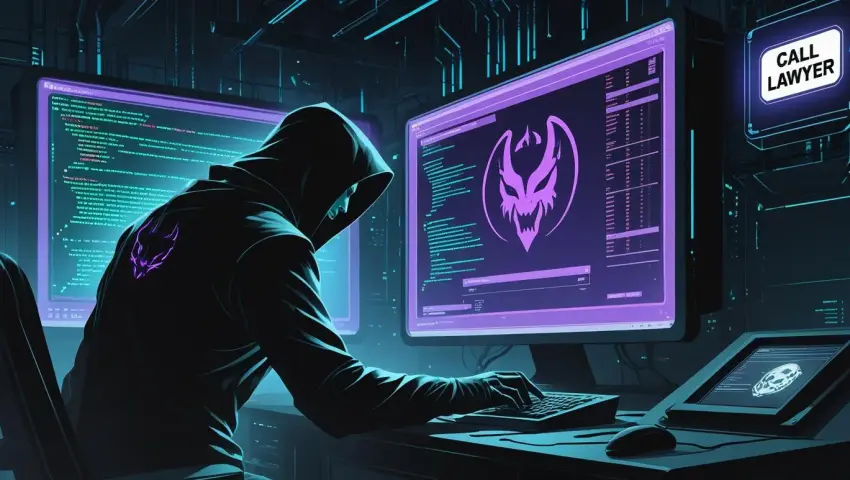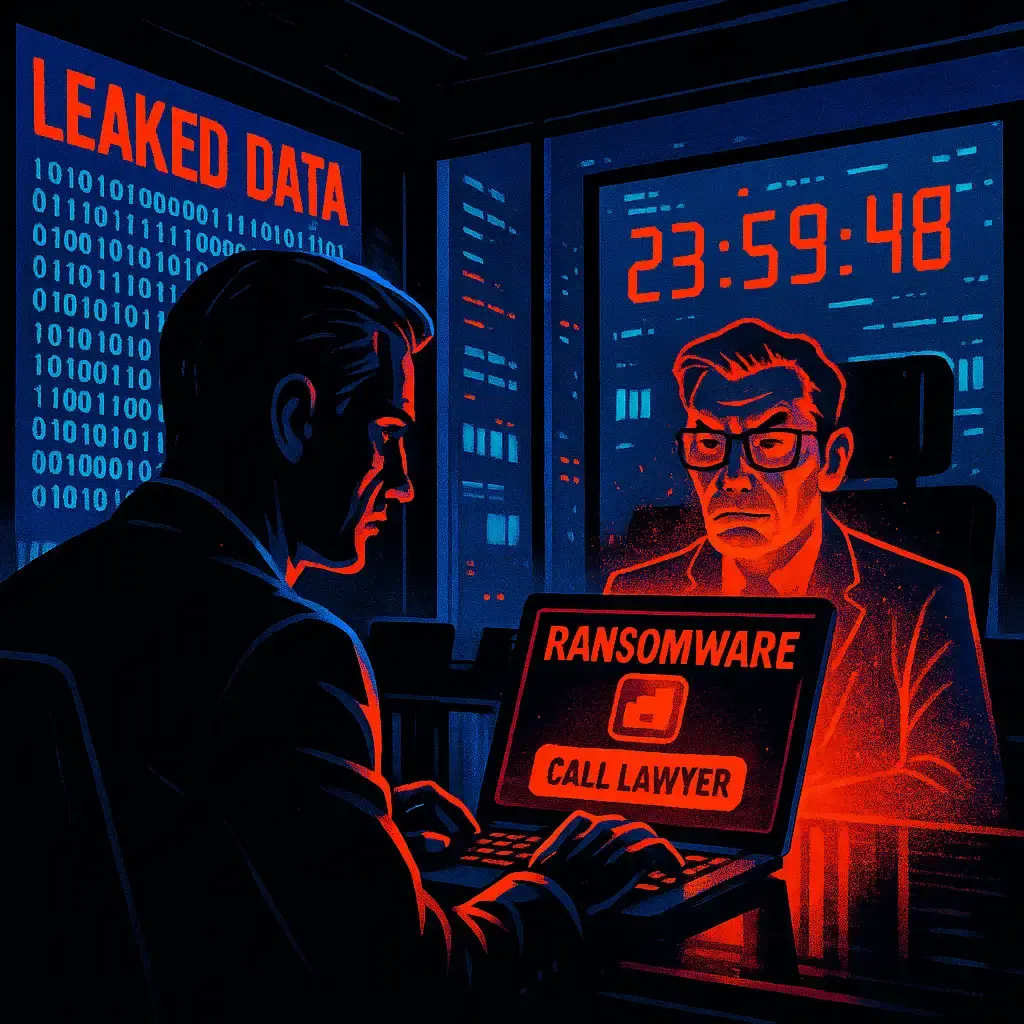
Digital Shakedown: How Qilin’s ‘Call Lawyer’ Scheme Turned Ransomware into Psychological Warfare
A New Era of Digital Extortion — The Rise of Qilin and the “Call Lawyer” Psy-Op
In the dim underworld of ransomware, where code is king and anonymity reigns supreme, a new predator stalks the digital shadows. The Qilin ransomware group—once just another name in the ransomware-as-a-service (RaaS) ecosystem—has now emerged as one of the most psychologically manipulative forces on the cybercrime landscape. Their latest innovation? A “Call Lawyer” button designed not to mediate disputes, but to torment minds.

Professionalism Meets Psychological Warfare
Qilin's evolution isn’t merely technological—it’s theatrical. The “Call Lawyer” feature, recently discovered in their affiliate control panel, is the ultimate performance of power. At the press of a button, the virtual room shifts. Suddenly, the victim isn’t just negotiating with an anonymous extortionist. They’re now being joined by a so-called legal expert—a “lawyer” whose job is not to advise, but to intimidate.
This figure, entirely fabricated, poses as an arbiter of legality, injecting faux legalese into the conversation. Victims have reported receiving ominous declarations like “refusal to pay may constitute obstruction” or “your data breach liabilities exceed statutory thresholds.” These aren't empty threats—they’re finely crafted manipulation tactics designed to exploit fear, guilt, and urgency. For companies already buckling under the weight of a cyberattack, the illusion of looming legal repercussions can tip the scales toward ransom payment.
Not Just Hackers—They’re Building a Brand
What makes Qilin particularly chilling is how they've borrowed tactics from legitimate business models. Their affiliate platform is polished, organized, and comprehensive—offering a suite of cybercrime tools like DDoS amplification, data leak publishing portals, and even spam email campaigns to amplify public pressure on victims. And yes, they offer “customer support,” if one can call it that, to their affiliates.
The “lawyer” addition is just the latest in a string of Qilin’s psychological warfare innovations. The group runs a dedicated public-facing leak site, where they publish portions of stolen data to prove their seriousness and humiliate the victims. They also reportedly employ what they call “in-house journalists” to write press-release-style blog posts about organizations that refuse to pay, further ramping up reputational damage.
Qilin isn’t just extorting data—they’re orchestrating chaos, wrapped in a polished user interface and delivered with the professionalism of a Silicon Valley startup. Their message to victims is clear: you’re not just under attack—you’re under siege.
The Curtain Rises: When Cybercrime Becomes Performance
For Qilin, the art of extortion isn’t just about encryption keys—it’s about narrative control. The “Call Lawyer” function is the climax of their psychological play. They’ve moved beyond the brutal efficiency of locking systems and are now writing scripts for fear. And like any good theater troupe, they know their audience: CEOs under public scrutiny, IT teams on the brink of collapse, boardrooms trapped in a crisis spiral.
In some cases, victims reported that once the “lawyer” entered the chat, the tone shifted dramatically—from criminal to courtroom. The illusion was carefully curated, with official-sounding disclaimers, references to GDPR violations, and the threat of regulatory action. One incident described the “lawyer” insisting that failing to respond would result in formal notifications to data protection authorities—an empty threat, but terrifying in the fog of crisis.
It’s a masterpiece of coercion, and it reveals a broader truth: modern ransomware is no longer just a technical threat. It is psychological warfare wrapped in a digital shell.

Victims in the Crossfire
Organizations victimized by Qilin often find themselves isolated. Many fear reporting the breach, wary of reputational damage or legal consequences. Those who do come forward describe a sense of surrealism—negotiating with faceless extortionists who shift into courtroom roles, all while their systems are crippled and their data hangs in the balance.
There have been reports of victims attempting to call the bluff, demanding bar registration numbers or legal credentials. But the Qilin “lawyers” are scripted to evade these queries, redirecting focus and doubling down on urgency. The tactic works—not because victims are gullible, but because they're desperate.
This desperation has led to more companies reluctantly paying ransoms, calculating that the cost of silence is lower than public humiliation or lawsuits. It's a decision no one wants to make—and one Qilin expertly engineers.
The Shaky Ethical Ground of Response
Here’s the most unsettling part: there’s no playbook for this kind of attack. Cybersecurity teams are trained to handle encryption, patch systems, and coordinate breach responses. But how do you prepare your staff for a virtual courtroom conjured by criminals?
Some experts argue that law enforcement and cybersecurity agencies need to collaborate more aggressively on psychological countermeasures—creating awareness campaigns that demystify these tactics, and providing real-time guidance for victims under pressure. Others warn that any response legitimizes the strategy and fuels the evolution of even more manipulative features.
And somewhere in the midst of it all are victims—real people—staring down a chat window, wondering if what’s unfolding is legal fiction or imminent disaster.
Turning Awareness into Armor
The first wave of response came not through code, but communication. Cybersecurity firms like Mandiant, CrowdStrike, and SentinelOne issued bulletins on Qilin’s psychological tactics, emphasizing the importance of recognizing manipulation alongside malware. Training modules are being updated to reflect this shift: where once IT teams practiced data recovery and incident response, they now role-play conversations with fictional extortionists and mock “lawyers.”
This pivot is about building resilience—not just patching vulnerabilities, but teaching people how to stay calm in the eye of a digital storm.
Cybersecurity Think Tanks Join the Fight
Institutions like the Carnegie Endowment for International Peace and the European Union Agency for Cybersecurity (ENISA) have begun convening panels on the human factors of ransomware. ENISA’s 2025 guidance even included sections on “social engineering dramatics” and recommended that crisis communications teams be trained in psychological triage.
Meanwhile, academic institutions are studying the behavioral impact of threats like Qilin’s. Some universities are piloting new programs at the intersection of infosec and cognitive science—an acknowledgment that future cybersecurity leaders will need as much empathy as they do technical prowess.
Global Legal and Policy Shifts
Governments, too, are waking up to the fact that Qilin’s methods aren’t just criminal—they’re calculated performances. In the EU, there’s mounting support for legislation that would allow anonymous ransomware reporting to law enforcement, helping companies avoid the PR fallout that often discourages transparency.
The U.S. Cybersecurity and Infrastructure Security Agency (CISA), in partnership with the FBI, has launched an initiative dubbed “False Authority Exposure,” aimed at unmasking the kinds of coercive personas deployed by groups like Qilin. Part public awareness campaign, part threat de-escalation toolkit, it’s designed to remind victims: that “lawyer” in the chat window isn’t your legal risk—it’s your attacker in costume.
Technology Strikes Back
On the tools front, security vendors are developing AI-driven context analyzers that can flag suspicious rhetoric in ransom negotiations—identifying when a criminal shifts tone, deploys legal-sounding language, or references real-world statutes in a deceptive way. Think of it as a lie detector for digital hostage-takers.
Additionally, digital forensics teams are crafting “persona deconstruction” reports, mapping out the consistent linguistic quirks of Qilin’s fabricated roles and sharing them across threat intelligence networks.

A Message to the Masked Threat Actors
And perhaps most powerfully, the defenders are taking back the narrative. At recent cybersecurity conferences, panels titled “Ransomware Theater” and “Negotiating with Ghosts” drew packed rooms. One white-hat hacker even spoofed Qilin’s interface during a live demo, ending with a twist: the “lawyer” character triggered a reminder that said, “You’re not a criminal mastermind. You’re a script kiddie in a mask.”
It got a standing ovation.
Layered to Last — Defeating Ransomware Theater with Structured Cyber Resilience
In the battle against ransomware operations like Qilin—who blend technical extortion with psychological theater—defense is no longer just digital. It’s strategic, human-aware, and deeply narrative. That’s where a Cy-Napea®-aligned approach to layered defense becomes vital. It doesn’t just stop the breach; it disrupts the performance.
Here’s how each layer plays its part in dismantling the script.
The First Line of Defense: Cybersecurity Awareness Training
The opening act of protection happens in the minds of the users. Ransomware theater depends on fear, confusion, and manipulation—so the best counters are education, practice, and confidence.
Simulated phishing campaigns help users spot social engineering traps before they're hooked.
Scenario-based workshops expose staff to psychological tactics, like the Qilin “lawyer,” in controlled environments—training them to stay calm when the drama unfolds.
Narrative recognition training teaches employees to spot when an attacker is not just lying, but performing.
With an informed, alert workforce, attackers lose their audience before the curtain even rises.

The Second Line of Defense: Advanced Email Security
Still the most common vector for intrusion, email is where many ransomware sagas begin. But it’s not just about blocking bad links—it’s about understanding deception.
AI-enhanced filters detect emotional language, fake legal rhetoric, and impersonation patterns.
Behavioral analytics flag anomalous tone shifts, such as emails that suddenly become authoritative or urgent.
Cy-Napea®-compatible platforms go one step further: they classify incoming threats not just by payload, but by intent.
This layer guards the inbox like a velvet rope outside the theater—keeping out the actors before they can take the stage.
The Third Line of Defense: EDR/XDR/MDR Solutions
When prevention fails, detection must be swift and decisive.
Endpoint Detection & Response (EDR) tools spot unauthorized encryption or data movement in real time.
Extended Detection & Response (XDR) unites telemetry from across the entire environment—email, cloud, network—to track storytelling threats holistically.
Managed Detection & Response (MDR) services combine expert insight with 24/7 monitoring, giving defenders time to frame the situation and avoid narrative collapse.
This is where defenders reclaim the script before it spirals beyond recovery.
The Last Line of Defense: Advanced Backup & One-Click Recovery
Every theater needs an exit plan. In ransomware, that’s backup.
Immutable backups ensure attackers can’t alter history—your data remains untouched, uncorrupted, and untouchable.
One-click recovery tools let organizations restore critical systems in minutes, denying the extortionists their finale.
Cy-Napea® advises parallel narrative recovery: while tech teams restore systems, communications teams restore trust—telling customers, partners, and press that the lights are back on and the story continues.
Here, even if Qilin steals the spotlight for a moment, they don’t get to write the ending.
Epilogue: Resilience by Design
Ransomware is no longer a solo act of encryption—it’s a fully staged performance of intimidation. But with layered defenses rooted in Cy-Napea® principles, organizations don’t just resist. They rewrite the narrative.
Because when your defenses are that well scripted, the attackers become just another act—and the audience always knows it’s make-believe.




